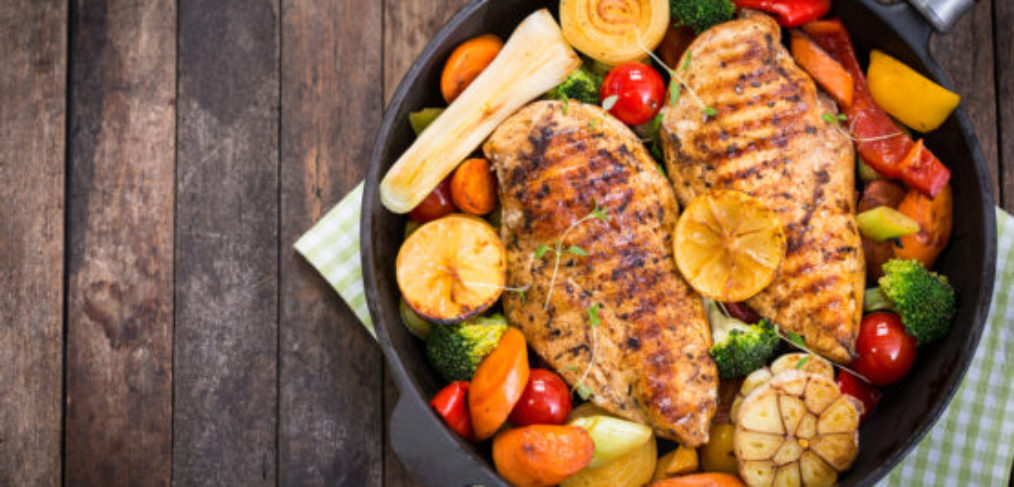Gluten Free by Default or Design?

What do you see when you look at this image?
What do you think of?
Perhaps fresh, healthy, balanced? Colorful? Organic? Would you think automatically that this is an example of a gluten-free meal?
Because it is.
If you’re eating a breakfast at 11 am consisting of fresh spinach you’ve sautéed in garlic and coconut oil, two or three farm fresh eggs over easy and a side of avocado with lime and salt, you’re eating gluten-free.
You might also say you’re just eating food, which would be accurate, but it’s also true to say that this meal did happen to be gluten free, too.
And if this is the general template you follow (local, fresh veggies in abundance, ample fat and mindfully sourced proteins), you’re ahead of what the typical American plate looks like by a long shot.
Another version of gluten free exists, too and sadly, this one is barely less toxic from what I often refer to as the Standard American Special.
It may not have gluten in it, but it can still be:
- High in refined sugars
- Inflammatory
- Acid producing
- Low in nutrient density
- Low in healthy Omega 3 fatty acids
So what’s the big deal if you have a gluten free cookie now and then, or start your day with a piece of gluten free toast?
A lot.
While a piece of gluten free bread may not result in you dropping dead right after breakfast, it’s worth your time to understand what’s wrong with simply using the term ‘gluten free’ as the only gauge of whether or not something is a smart choice for you and your family.
First things first; the most natural, real foods we can choose aren’t going to come in a package anyway, therefore not warranting the use of this silly phrase.
So what is really broken about this picture, then?
Gluten isn’t the only toxic compound we ingest when we eat wheat, barley, rye (or oats- depending on who you ask); Mark Sisson provides a comprehensive review in his article, The Problems with Modern Wheat (1)
If we look only at a packaged food item’s label to see if it contains gluten or not, it’s no less valuable than looking at a label to see total calories or fat grams and not looking at anything else. Gluten or no gluten, it’s only one small piece of the information we need to have what we need to make an educated choice to put the item in our body or not.
Making the assumption that a diet with a large dependence on gluten-free labeled items translates to one thing: a diet high in packaged food. This inherently is not going to be as fresh, and as a result, not as rich in micronutrients making it an inferior choice to eat day in and day out. Imagine an athlete comparing a loaf of packaged, gluten-free bread to a couple of organic yams from the farmer’s market and trying to decide which is the better source of starch to add to their dinner the night before a race. Not too tough of a choice.
It’s also worth factoring in who benefits from the hopping on the gluten free bandwagon. The gluten-free products industry is seen expanding by about 10 percent a year, with annual sales reaching $7 billion worldwide by 2020, according to a recent Bloomberg report (2). Do you think Kraft and Nestle are selling us their stuff is healthy because they’re concerned about our inflammation and gut health?
Finally, don’t forget about food trends. They may start with some validity, an honest concept, sometimes stemming from research that actually proved something with a strategy and hope to carry it to the masses to make a difference. Others may only ever be a trend started by someone without the education or background to be in the place to be offering advice in the first place. In either case, it’s just that- a trend. One that far too many people begin to implement with or without understanding the why behind it, in hopes of reaching an unattainable goal in a very short period of time. Gluten-free does not automatically equal healthy or good for you, any more than a label stating something is ‘vegan’ or ‘paleo’ does.
At the end of the day, we simply need to toss out all the labels and whether you choose to eat grass fed meat, boycott all animal products or decide not to eat after 7pm, there’s only one question we need to ask ourselves to determine whether or not X food should be part of our diet: is it food?
In other words, is it a substance that when eaten, will nourish us, promote growth, brain development and not just survival but thriving?
Or will it create inflammation in our guts leading to brain fog, weight gain, a reliance on sugar and an endless list of subsequent health issues that far too many people are existing in, thinking this it normal and ok because everyone around them is also feeling poorly?
Unacceptable, in my opinion, to settle for this.
Ask yourself:
Did this grow near where I live? Or did it run across the land or swim in the waters? How many steps did it take for this food to get to my plate? If it is in a package, does it have very few ingredients, as in one, that I can identify as food?
If the answer to any of the above is a resounding NO, chances are you can make a better choice.
Caveat: there will be times and places when best option #1 is not an option and we have to then choose as wisely as we can.
In the big picture, however, if we choose real food first for the majority of the time we can begin to set the path for healing if you are in the category of sub clinically ill (I was there for years, so I know the space all too well), or clear the way even more if you’ve already begun the journey.
That, along with setting reasonable, attainable goals for yourself can pave the way to a successful transition to achieving and maintaining optimal health, fueled by food.
And it isn’t going to feel like a diet.
(1) http://www.marksdailyapple.com/the-problems-with-modern-wheat/
(2) https://www.bloomberg.com/news/articles/2017-04-11/against-the-grain-traders-going-gluten-free-in-quest-for-profit





